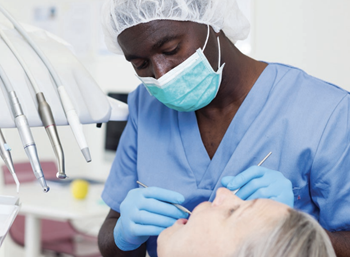In rural oral health, equity starts with workforce diversity
 Eleanor Fleming, DDS, MPH, PhD |
Building a diverse dental health workforce is a key component of health equity, which is critical to improving oral health access in rural America. We can all be part of this mission when we nurture opportunities for diverse groups in dental health professions.
Eleanor Fleming, DDS, MPH, PhD, is a dental epidemiologist and board-certified public health dentist currently serving as associate professor at the School of Dentistry at Meharry Medical College, a historically Black medical school in Nashville, Tenn. She focuses on population-level health, monitoring data, and measuring disease across ages and racial and ethnic groups.
The data shows that dental school enrollment numbers for African Americans, Hispanics, American Indian, and Alaska Native students have been stagnant for decades. At the same time, research suggests a pattern of disparities in dental care access and outcomes for people of color.
“Studies show that when the clinical presentation and findings on X-rays for two patients are the same, the white patient is more likely to be counseled on options to save the tooth with a root canal, while the Black patient is given the option for tooth extraction,” Fleming explains. “It’s striking to me that the differences in oral health outcomes for people of color persist. We know that outcomes improve when there is concordance between patient and provider in the medical field, and I can’t help but wonder if expanding the diversity of the workforce in dentistry could help close some of those gaps in oral health.”
"I find myself becoming a more vocal champion for dental public health and oral health equity. This is the lens through which I approach these issues, always thinking about the role of the science and evidence-based research."
-Eleanor Fleming
Advancing oral health equity
Focusing on equity and improving access to oral health care requires an active strategy and the combined efforts of many stakeholders. “We need to strive for a model for social change to transform consciousness and transform structure in dentistry. Workforce diversity is an area where we can collectively move the needle toward reaching these goals and be a catalyst for change,” Fleming says.
Dealing with barriers that impede overall health — transportation, housing, health insurance, language barriers, and more — can improve access for diverse populations in underserved rural areas. “Even though we may not have solutions for the overarching societal issues, we can build credibility and trust to overcome barriers by having a more diverse workforce in dental health,” Fleming says. “People are more likely to act on the resources and referrals of someone they know and trust.”
A more diverse and culturally competent workforce can be better listeners who understand what matters to people of color and immigrant populations. They can communicate in a familiar language, recognize important cultural issues, and help patients feel comfortable making decisions about their oral health.
Increasing the diversity of the workforce to include dentists, hygienists, dental therapists, and other roles can also make a difference. “The path to solutions starts with the conversations that push us to think critically about addressing inequity through individual and institutional growth,” Fleming says.
Education and training
For many decades, barriers prevented people of color from entering the dental profession. Today, anyone can pursue a career in oral health, but the pathway to dentistry can be more difficult for Black and Indigenous individuals and people of color due to societal and economic pressures. “As with all things, we need to understand the history to make sense of where we are now,” Fleming says.
Making a positive change for the future starts with creating a pathway to dentistry for the student. This can be as simple as educating and encouraging children to participate in more advanced professions. “Helping students plan their academic careers for college readiness can give them the confidence they need to be successful,” Fleming says.
Student loan assistance
 The prospect of incurring a massive amount of student loan debt can be a difficult hurdle for any student, especially diverse and rural student populations lacking economic resources. Helping students navigate scholarships, grants, and loans can remove barriers and encourage those from diverse backgrounds to enroll in professional programs.
The prospect of incurring a massive amount of student loan debt can be a difficult hurdle for any student, especially diverse and rural student populations lacking economic resources. Helping students navigate scholarships, grants, and loans can remove barriers and encourage those from diverse backgrounds to enroll in professional programs.
“On a larger scale, we need a better framework for dealing with loan repayment and incentivizing those who pursue a career in dentistry serving their community,” Fleming says. “We can advocate for policies around student loans that make the path to dentistry more feasible and realistic.”
Hiring and retention
Decisions about recruiting, hiring, and retention play a significant role in where dental professionals are placed — and where they stay. Reaching beyond established professional circles when recruiting and posting jobs can help bring in a more diverse pool of candidates for all positions.
“Retention of a diverse workforce can be the hardest nut to crack. It takes community involvement in creating a welcoming environment where people are supported and encouraged to build a life and be part of the community,” Fleming says.
Mentoring
Mentoring is a best practice in medicine, dentistry, and other fields that can have a powerful impact on the course of a person’s career. “Anyone can serve as mentor to a student of color and provide opportunities for shadowing and sharing experience and insights,” Fleming notes.
Activism
“We need to recognize how big the problem is and figure out how to tackle persistent disparities,” Fleming says. “As dentists, we may choose to donate our time at a site for underserved populations or enroll as a Medicaid provider. We may pursue roles teaching and training the next generation of dentists. We can affiliate with the medical groups and dental societies doing the work of health equity.”
Fleming encourages others to leverage their power and advocate for those who don’t have a voice or a seat at the table. “By engaging in authentic relationships and having purposeful conversations, we can effect transformational change in the ecosystem,” she says. “NRHA members have a unique lens through which to think about dental health equity with all the complexity and diversity that goes into a rural setting. They can amplify the issue by sharing their stories and speaking up to make sure rural is included in discussions about dental public health.”
